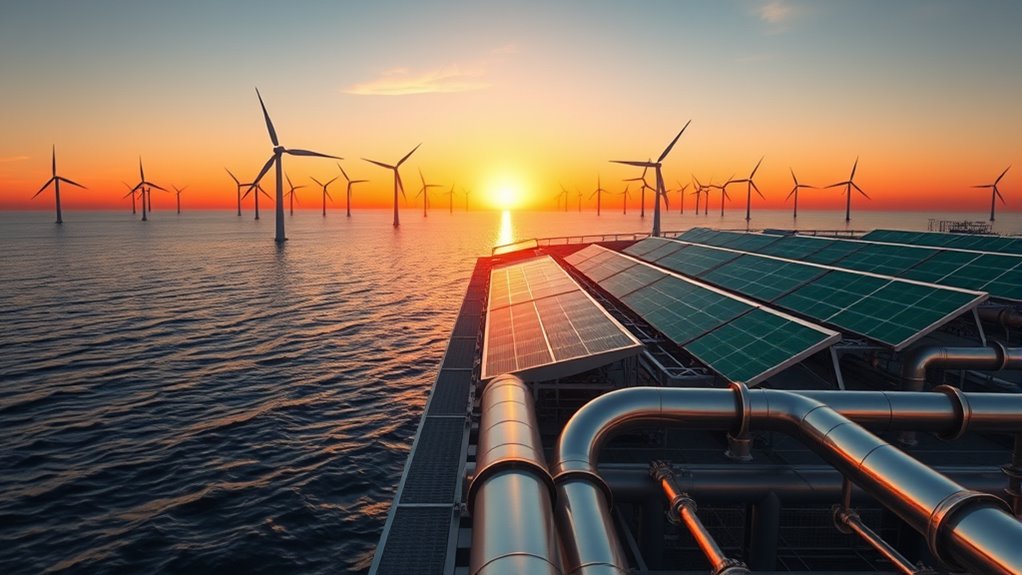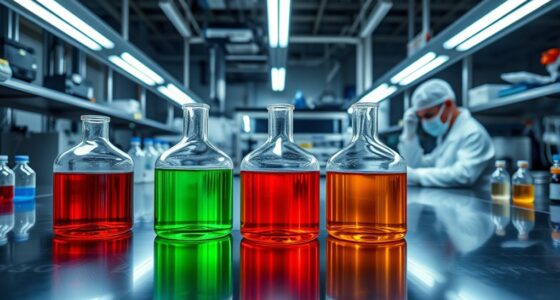Offshore wind offers a reliable, abundant source of renewable energy vital for producing green ammonia without fossil fuels. By using wind-powered electrolyzers, you can convert electricity into green hydrogen, which then combines with nitrogen to synthesize ammonia sustainably. Technological advances address efficiency and cost challenges, making this greener process more viable. As policies support growth and innovation continues, offshore wind-to-chemicals could revolutionize low-carbon fertilizer and fuel production—explore further to see how these developments unfold.
Key Takeaways
- Offshore wind provides abundant, reliable renewable electricity essential for green ammonia synthesis, replacing fossil fuels and reducing emissions.
- Wind energy is converted into green hydrogen via electrolyzers, which then combine with nitrogen to produce ammonia sustainably.
- Technologies like catalyst-coated meshes and modular offshore units enhance process efficiency and scalability for offshore ammonia production.
- Integrating offshore wind with direct air capture and energy storage solutions supports continuous, flexible, and low-carbon ammonia manufacturing.
- Scaling offshore wind-powered ammonia reduces greenhouse gases and air pollutants, advancing environmentally sustainable fertilizer and chemical industries.
The Promise of Offshore Wind for Ammonia Production
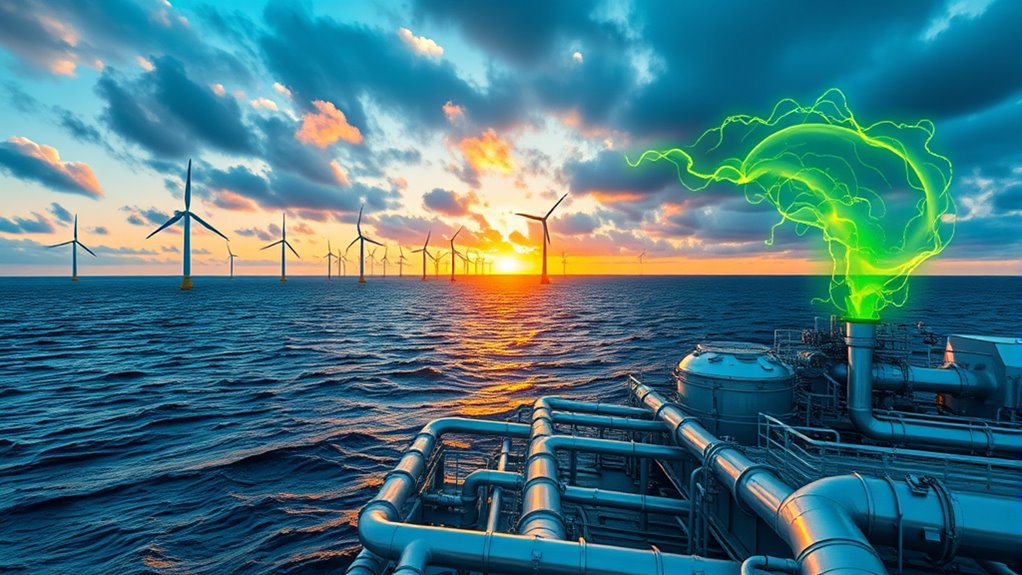
Offshore wind holds great promise for revolutionizing ammonia production by providing a reliable, large-scale source of renewable energy. Unlike onshore wind, offshore sites like the U.S. Gulf of Maine offer stronger, steadier winds, ensuring more consistent electricity generation. This consistent power enables ammonia plants to operate at high capacities, with projects targeting up to 300,000 tons annually. Using offshore wind energy allows you to decarbonize ammonia manufacturing, replacing fossil fuels with green electricity. Although current costs are higher than traditional methods, offshore wind’s stability reduces exposure to fuel price fluctuations. As technological advances and economies of scale improve, costs are expected to decrease. Additionally, integrating sustainable agricultural practices with renewable energy sources can further enhance the environmental benefits of green ammonia production. The development of offshore wind infrastructure is crucial for scaling up renewable energy capacity and achieving widespread adoption. Investing in renewable energy integration can also optimize overall operational efficiency and sustainability. Ultimately, offshore wind can supply the substantial, clean energy needed to produce ammonia sustainably at scale.
Technologies Enabling Wind-Driven Ammonia Synthesis
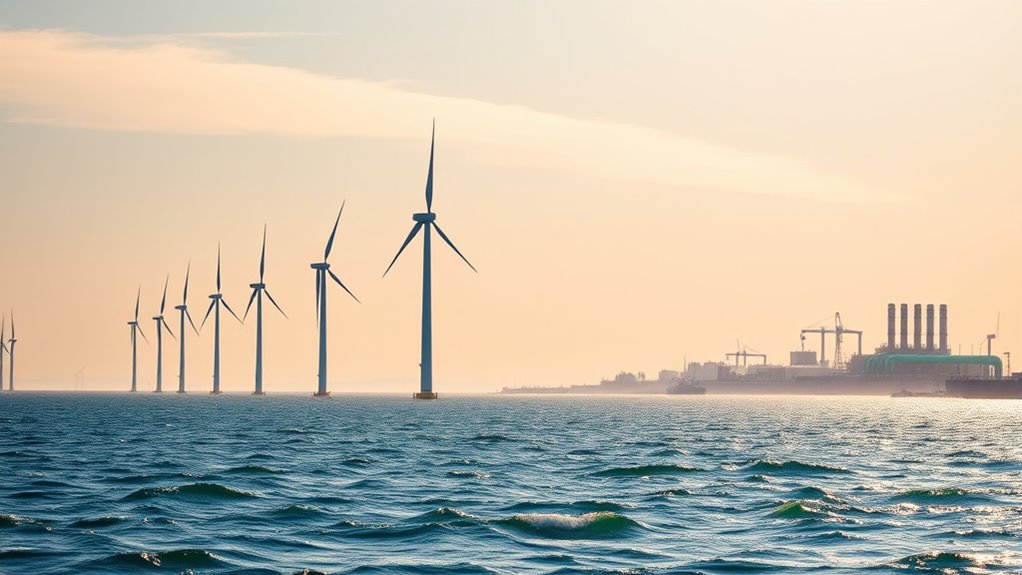
Advances in technology are making wind-driven ammonia synthesis increasingly feasible by integrating existing systems with innovative materials and processes. Small-scale systems, like those developed at the University of Minnesota, use wind-powered water and air to produce ammonia efficiently.
Researchers at Stanford employ catalyst-coated meshes to extract nitrogen from air and hydrogen from water vapor, streamlining the synthesis process. These catalysts enhance reaction rates and improve overall system efficiency, making the process more viable for large-scale applications.
Offshore wind can be converted into liquid ammonia using established technologies, enabling transportation and applications like fertilizers and fuels. All-electric systems powered by wind turbines, coupled with electrolyzers, split water into hydrogen, which then combines with nitrogen. Electrolyzer efficiency is a critical factor influencing the overall success of wind-to-ammonia conversion, as it determines how effectively water is split into hydrogen.
To guarantee consistent operation, grid integration and backup systems support the process. Implementing monitoring systems is crucial for detecting signs of spoilage in ammonia synthesis systems, as they can affect output quality and process stability, highlighting the importance of monitoring system conditions.
These technological advances improve scalability, efficiency, and economic viability of wind-driven ammonia production.
Overcoming Efficiency and Capital Cost Challenges
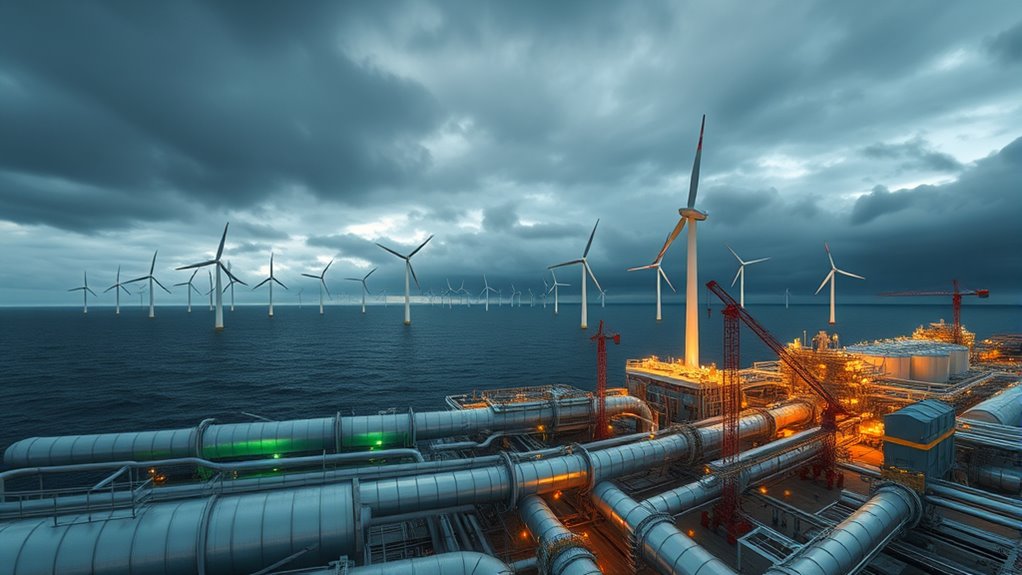
While technological innovations are making wind-driven ammonia synthesis more practical, significant hurdles remain in boosting efficiency and reducing costs. Material limitations, like costly components that aren’t optimized for maximum energy use, hinder performance. Energy losses during transmission and conversion further reduce overall efficiency. Noise levels of modern heat pumps can be minimized with advanced technology, contributing to more sustainable operations. Marine environments cause corrosion, degrading materials and risking environmental hazards. The intermittent nature of wind leads to supply inconsistencies, complicating process stability. The energy storage challenges associated with variable wind supply necessitate innovative solutions to ensure continuous operation. Additionally, the increasing complexity of automated systems in chemical manufacturing introduces new challenges for system coordination and maintenance. Integrating wind energy with chemical synthesis requires advanced system coordination, adding complexity.
Economic Factors Shaping Green Ammonia Viability
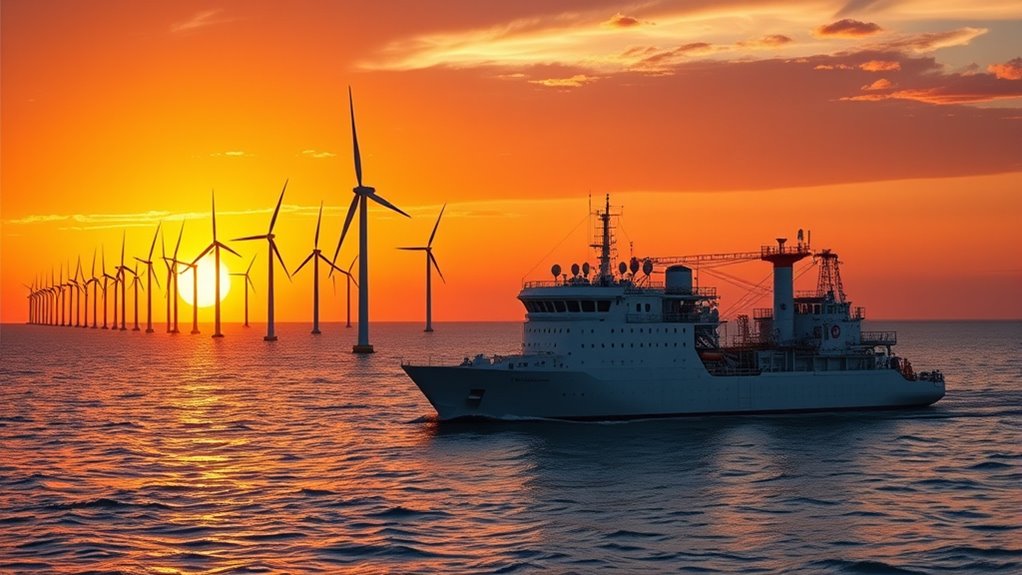
Economic factors play a crucial role in determining the viability of green ammonia projects. The high upfront capital expenditure, mainly from electrolyzers and renewable energy systems, influences project feasibility.
While operating costs are lower than fossil-based systems due to no fuel expenses, financing costs and interest rates heavily impact economic outcomes, especially in riskier regions.
Advances in electrolyzer technology are expected to reduce costs further by 2030, improving competitiveness.
Plant size and modularity affect economies of scale, with larger plants lowering per-unit costs but facing grid and energy supply challenges.
Market prices for green ammonia are currently higher than conventional, but gaps are narrowing.
Incentives like grants, low-interest loans, and carbon credits can enhance financial viability, while proximity to renewable sources reduces infrastructure costs.
The role of renewable energy also significantly influences the overall cost structure and sustainability of green ammonia production.
Environmental Benefits of Renewable Ammonia
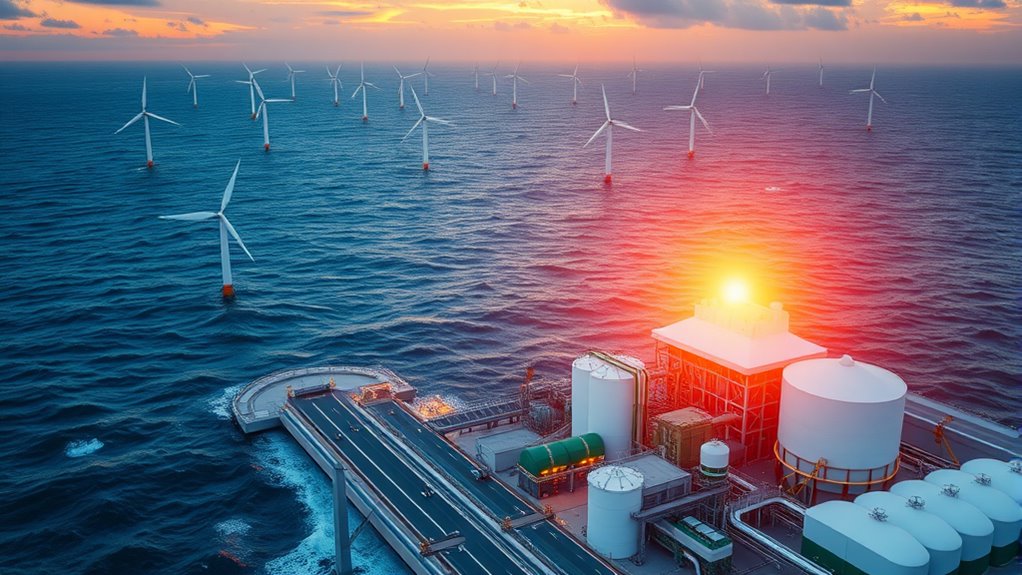
Green ammonia offers significant environmental benefits by dramatically reducing carbon emissions associated with traditional ammonia production. Instead of relying on natural gas steam reforming, it uses water electrolysis powered by renewables, eliminating CO2 emissions from hydrogen sourcing.
Green ammonia drastically cuts carbon emissions by replacing fossil fuels with renewable-powered water electrolysis.
Traditional processes emit about 2 tons of CO2 per ton of ammonia, but green methods avoid this entirely. Scaling up green ammonia globally could cut substantial greenhouse gases from fertilizer manufacturing, a major contributor to global emissions.
Using offshore wind-generated electricity enhances these savings by providing abundant clean energy. Green ammonia also reduces air pollutants like nitrogen oxides and particulate matter, improving local air quality.
Plus, it minimizes methane leakage risks and lessens ecosystem disruption caused by fossil fuel extraction, supporting a cleaner, more sustainable environment.
System Designs for Offshore Wind‑to‑Chemicals Integration
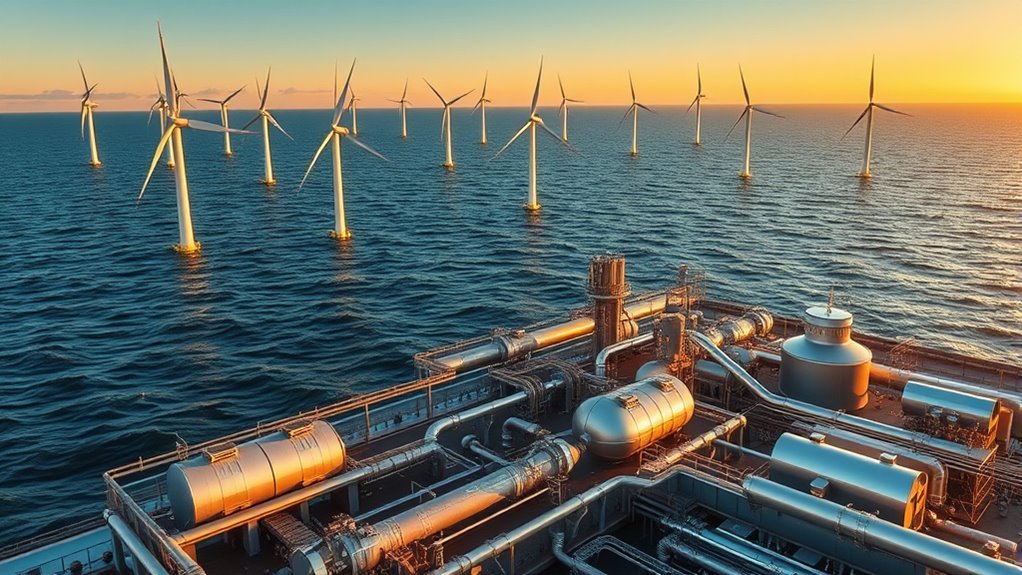
Integrating offshore wind energy with chemical production requires innovative system designs that can adapt to variable power supply and maximize efficiency. Dynamic green ammonia plants, directly linked to offshore wind, adjust operations based on fluctuating energy, boosting synthesis efficiency.
Incorporating energy storage, hydrogen production, and hybrid interconnectors improves subsea cable utilization, reducing idle times caused by limited wind transmission. Advanced system integration solutions help alleviate grid congestion and foster increased demand for renewable electricity, supporting large-scale offshore wind projects.
Participating in multi-stakeholder research and hybrid connection studies equips you with expertise to secure global tenders for power-to-X projects, including ammonia synthesis. Investment in electrolyzer flexibility and industrial coupling is essential to lowering costs and enhancing competitiveness, ensuring seamless, efficient offshore wind-to-chemicals integration.
The Role of Grid Backup and System Flexibility

As offshore wind systems expand, ensuring reliable power supply becomes increasingly complex due to variability and transmission limitations. You need backup power solutions, like batteries or hydrogen production, to stabilize the grid during low wind periods.
Grid decarbonization requires continuous renewable build-out, especially when weather conditions are unfavorable. Power curtailment helps manage wind variability, improving overall system economics.
Using grid backup can also save fuel at power plants by increasing efficiency. System flexibility enables dispatchable power, allowing for better energy management.
Offshore hydrogen production, decoupled from grid constraints, offers a flexible storage option. Advanced techno-economic models and storage solutions make integrating flexible systems more cost-effective, supporting a resilient, low-carbon offshore energy infrastructure.
Advancements and Future Directions in Sustainable Production
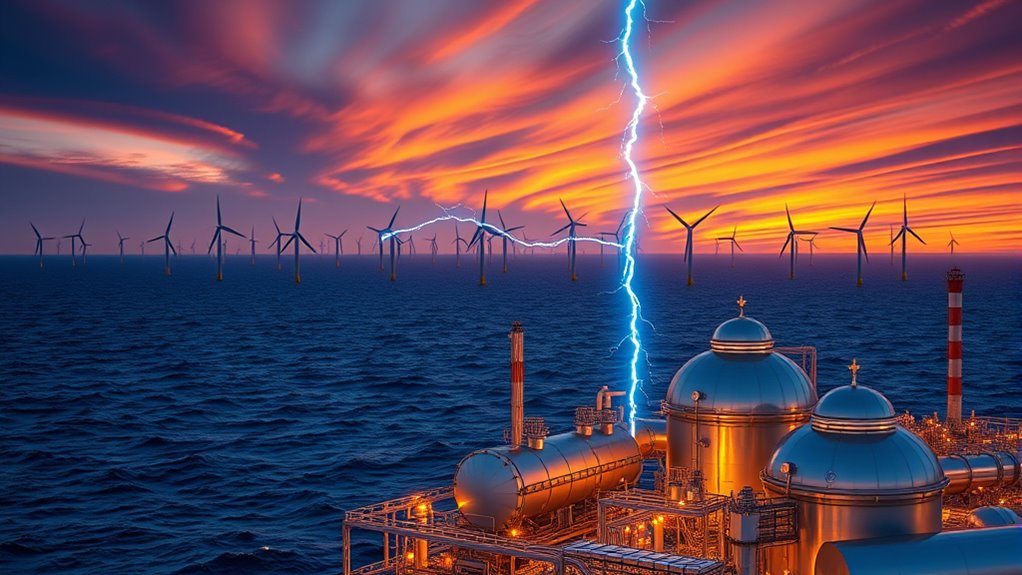
Advancements in offshore wind-to-ammonia conversion are driving the development of more efficient and sustainable production methods. Integrating wind farms with electrolyzers allows you to produce green hydrogen directly from renewable energy, cutting emissions.
Progress in electrochemical ammonia synthesis aims to replace traditional Haber-Bosch processes, lowering carbon footprints. Modular, scalable offshore units enable decentralized production close to wind resources, reducing transportation energy.
Coupling offshore wind with direct air capture technology provides a sustainable CO2 source, further enhancing environmental benefits. Research on catalysts and reactor designs improves efficiency and reduces energy demands, making the process more viable.
These innovations support long-term energy storage, offer system flexibility, and open pathways for scalable, eco-friendly ammonia production, aligning industry growth with sustainability goals.
Unlocking Market Potential and Policy Support
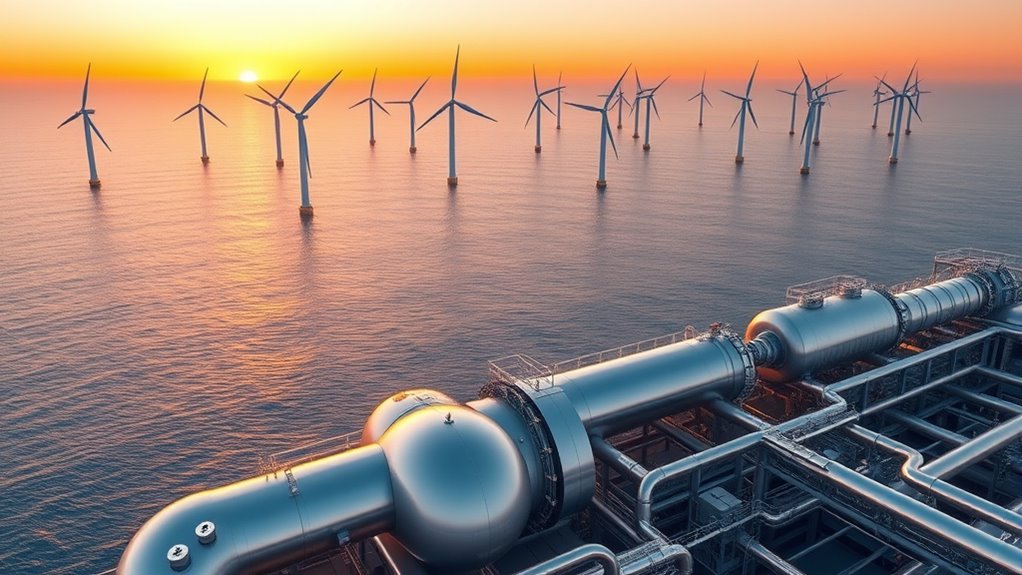
Revealing the market potential for offshore wind-to-chemicals hinges on robust policy support and strategic investments. With global offshore wind capacity projected to reach 422–492 GW by 2035, your opportunities grow as the sector expands at a CAGR of around 12.7%.
Governments worldwide set renewable targets that include offshore wind, backed by incentives, subsidies, and streamlined regulations that reduce project risks. These policies encourage private investments and foster public-private partnerships.
The proximity of abundant offshore wind resources to industrial hubs makes green ammonia production viable, especially as costs decline with technological advancements. As global ambitions to decarbonize industries like fertilizer manufacturing and shipping fuel increase, supportive policies will be vital in overcoming high upfront costs and supply chain challenges, revealing the full market potential.
Frequently Asked Questions
What Are the Main Environmental Impacts of Offshore Wind‑To‑Chemicals Projects?
The main environmental impacts of offshore wind‑to‑chemicals projects include chemical emissions from corrosion protection systems that release metals into waters, risking marine life and food safety.
You’ll also see habitat disruptions from infrastructure construction affecting seabed ecosystems.
These projects can lead to metal accumulation in seafood, threatening human health and fisheries.
Additionally, monitoring challenges may delay impact detection, emphasizing the need for stricter regulations and eco-friendly technologies to minimize ecological harm.
How Does Ammonia Storage and Transportation Affect Project Feasibility?
Ammonia storage and transportation substantially impact project feasibility because they require substantial infrastructure, like insulated tanks and refrigerated vessels, which increase costs.
You’ll need safety systems for handling its toxicity and corrosiveness, adding complexity.
The logistics of transporting ammonia—by sea, land, or pipeline—also involve high capital and operational expenses.
These factors can challenge the economic viability of your project, demanding careful planning and investment to guarantee safety and efficiency.
What Are the Safety Considerations for Offshore Ammonia Synthesis Facilities?
You might believe ammonia is safe because it’s widely used, but offshore synthesis demands rigorous safety measures. You must prevent leaks with gas-tight bulkheads, continuous monitoring, and quick shutdowns. PPE and specialized training protect your team from its toxicity.
How Do Regional Policies Influence Offshore Wind‑To‑Chemical Development?
Regional policies shape offshore wind-to-chemical development by setting clear targets, coordinating transmission planning, and establishing environmental standards. You’ll find that programs like OREC incentivize projects, while regional harmonization efforts streamline regulations across borders.
These policies also influence permitting, environmental compliance, and market incentives, making it easier for you to develop infrastructure, access funding, and ensure long-term sustainability.
Ultimately, coordinated policies promote more efficient, environmentally responsible growth of offshore chemical production.
What Are Potential Risks Associated With Floating Offshore Ammonia Plants?
You should be aware that floating offshore ammonia plants pose environmental, safety, operational, and regulatory risks. Fish and marine life may get entangled or disrupted, while ammonia leaks can cause serious health hazards.
Harsh weather and technical complexities threaten stable operation, and the lack of clear regulations increases accident risks.
Conflicts with fisheries and market uncertainties could also impact project success, making careful planning and monitoring critical.
Conclusion
As you explore offshore wind-to-chemicals, imagine a future where green ammonia fuels industries with clean energy. With advancements in technology and supportive policies, you can see how renewable power transforms chemical manufacturing. Doesn’t it make you wonder what’s possible when wind and water work together to create a sustainable world? Embracing these innovations now could power a greener tomorrow—so, are you ready to be part of this energy revolution?
